Rex Ying
Hyperbolic Deep Learning for Foundation Models: A Survey
Jul 23, 2025Abstract:Foundation models pre-trained on massive datasets, including large language models (LLMs), vision-language models (VLMs), and large multimodal models, have demonstrated remarkable success in diverse downstream tasks. However, recent studies have shown fundamental limitations of these models: (1) limited representational capacity, (2) lower adaptability, and (3) diminishing scalability. These shortcomings raise a critical question: is Euclidean geometry truly the optimal inductive bias for all foundation models, or could incorporating alternative geometric spaces enable models to better align with the intrinsic structure of real-world data and improve reasoning processes? Hyperbolic spaces, a class of non-Euclidean manifolds characterized by exponential volume growth with respect to distance, offer a mathematically grounded solution. These spaces enable low-distortion embeddings of hierarchical structures (e.g., trees, taxonomies) and power-law distributions with substantially fewer dimensions compared to Euclidean counterparts. Recent advances have leveraged these properties to enhance foundation models, including improving LLMs' complex reasoning ability, VLMs' zero-shot generalization, and cross-modal semantic alignment, while maintaining parameter efficiency. This paper provides a comprehensive review of hyperbolic neural networks and their recent development for foundation models. We further outline key challenges and research directions to advance the field.
HEIST: A Graph Foundation Model for Spatial Transcriptomics and Proteomics Data
Jun 11, 2025Abstract:Single-cell transcriptomics has become a great source for data-driven insights into biology, enabling the use of advanced deep learning methods to understand cellular heterogeneity and transcriptional regulation at the single-cell level. With the advent of spatial transcriptomics data we have the promise of learning about cells within a tissue context as it provides both spatial coordinates and transcriptomic readouts. However, existing models either ignore spatial resolution or the gene regulatory information. Gene regulation in cells can change depending on microenvironmental cues from neighboring cells, but existing models neglect gene regulatory patterns with hierarchical dependencies across levels of abstraction. In order to create contextualized representations of cells and genes from spatial transcriptomics data, we introduce HEIST, a hierarchical graph transformer-based foundation model for spatial transcriptomics and proteomics data. HEIST models tissue as spatial cellular neighborhood graphs, and each cell is, in turn, modeled as a gene regulatory network graph. The framework includes a hierarchical graph transformer that performs cross-level message passing and message passing within levels. HEIST is pre-trained on 22.3M cells from 124 tissues across 15 organs using spatially-aware contrastive learning and masked auto-encoding objectives. Unsupervised analysis of HEIST representations of cells, shows that it effectively encodes the microenvironmental influences in cell embeddings, enabling the discovery of spatially-informed subpopulations that prior models fail to differentiate. Further, HEIST achieves state-of-the-art results on four downstream task such as clinical outcome prediction, cell type annotation, gene imputation, and spatially-informed cell clustering across multiple technologies, highlighting the importance of hierarchical modeling and GRN-based representations.
TRACE: Grounding Time Series in Context for Multimodal Embedding and Retrieval
Jun 10, 2025Abstract:The ubiquity of dynamic data in domains such as weather, healthcare, and energy underscores a growing need for effective interpretation and retrieval of time-series data. These data are inherently tied to domain-specific contexts, such as clinical notes or weather narratives, making cross-modal retrieval essential not only for downstream tasks but also for developing robust time-series foundation models by retrieval-augmented generation (RAG). Despite the increasing demand, time-series retrieval remains largely underexplored. Existing methods often lack semantic grounding, struggle to align heterogeneous modalities, and have limited capacity for handling multi-channel signals. To address this gap, we propose TRACE, a generic multimodal retriever that grounds time-series embeddings in aligned textual context. TRACE enables fine-grained channel-level alignment and employs hard negative mining to facilitate semantically meaningful retrieval. It supports flexible cross-modal retrieval modes, including Text-to-Timeseries and Timeseries-to-Text, effectively linking linguistic descriptions with complex temporal patterns. By retrieving semantically relevant pairs, TRACE enriches downstream models with informative context, leading to improved predictive accuracy and interpretability. Beyond a static retrieval engine, TRACE also serves as a powerful standalone encoder, with lightweight task-specific tuning that refines context-aware representations while maintaining strong cross-modal alignment. These representations achieve state-of-the-art performance on downstream forecasting and classification tasks. Extensive experiments across multiple domains highlight its dual utility, as both an effective encoder for downstream applications and a general-purpose retriever to enhance time-series models.
Learning Along the Arrow of Time: Hyperbolic Geometry for Backward-Compatible Representation Learning
Jun 06, 2025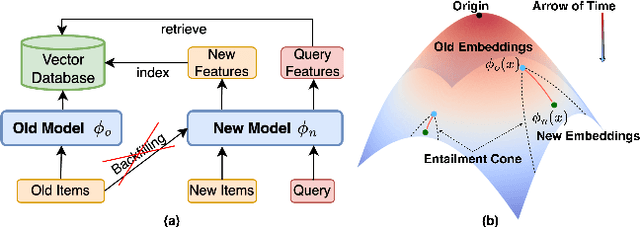
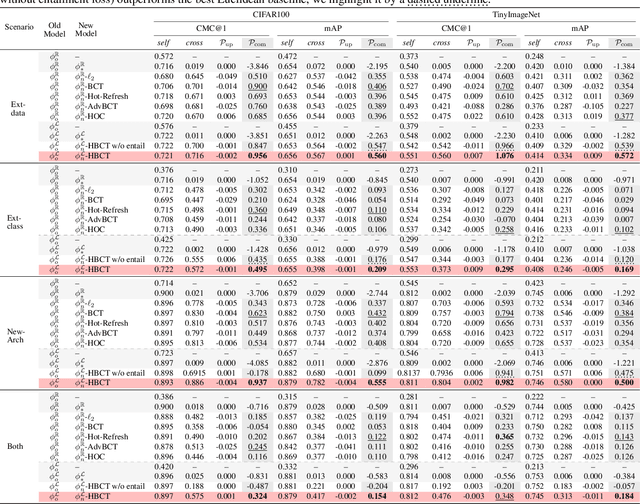
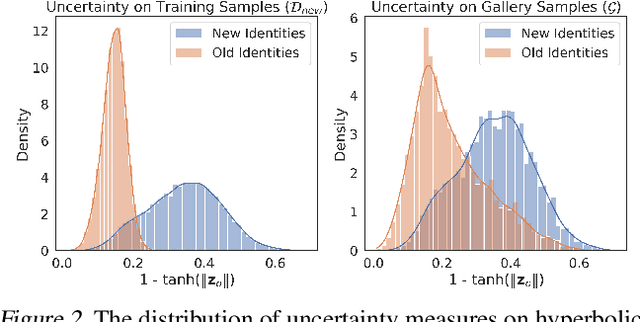
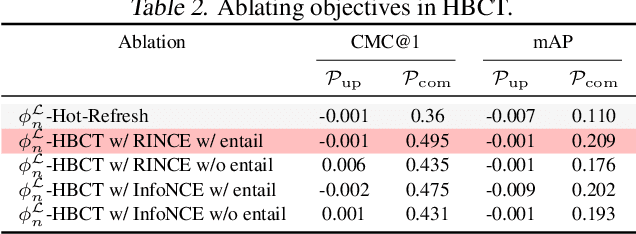
Abstract:Backward compatible representation learning enables updated models to integrate seamlessly with existing ones, avoiding to reprocess stored data. Despite recent advances, existing compatibility approaches in Euclidean space neglect the uncertainty in the old embedding model and force the new model to reconstruct outdated representations regardless of their quality, thereby hindering the learning process of the new model. In this paper, we propose to switch perspectives to hyperbolic geometry, where we treat time as a natural axis for capturing a model's confidence and evolution. By lifting embeddings into hyperbolic space and constraining updated embeddings to lie within the entailment cone of the old ones, we maintain generational consistency across models while accounting for uncertainties in the representations. To further enhance compatibility, we introduce a robust contrastive alignment loss that dynamically adjusts alignment weights based on the uncertainty of the old embeddings. Experiments validate the superiority of the proposed method in achieving compatibility, paving the way for more resilient and adaptable machine learning systems.
HELM: Hyperbolic Large Language Models via Mixture-of-Curvature Experts
May 30, 2025



Abstract:Large language models (LLMs) have shown great success in text modeling tasks across domains. However, natural language exhibits inherent semantic hierarchies and nuanced geometric structure, which current LLMs do not capture completely owing to their reliance on Euclidean operations. Recent studies have also shown that not respecting the geometry of token embeddings leads to training instabilities and degradation of generative capabilities. These findings suggest that shifting to non-Euclidean geometries can better align language models with the underlying geometry of text. We thus propose to operate fully in Hyperbolic space, known for its expansive, scale-free, and low-distortion properties. We thus introduce HELM, a family of HypErbolic Large Language Models, offering a geometric rethinking of the Transformer-based LLM that addresses the representational inflexibility, missing set of necessary operations, and poor scalability of existing hyperbolic LMs. We additionally introduce a Mixture-of-Curvature Experts model, HELM-MICE, where each expert operates in a distinct curvature space to encode more fine-grained geometric structure from text, as well as a dense model, HELM-D. For HELM-MICE, we further develop hyperbolic Multi-Head Latent Attention (HMLA) for efficient, reduced-KV-cache training and inference. For both models, we develop essential hyperbolic equivalents of rotary positional encodings and RMS normalization. We are the first to train fully hyperbolic LLMs at billion-parameter scale, and evaluate them on well-known benchmarks such as MMLU and ARC, spanning STEM problem-solving, general knowledge, and commonsense reasoning. Our results show consistent gains from our HELM architectures -- up to 4% -- over popular Euclidean architectures used in LLaMA and DeepSeek, highlighting the efficacy and enhanced reasoning afforded by hyperbolic geometry in large-scale LM pretraining.
Towards Non-Euclidean Foundation Models: Advancing AI Beyond Euclidean Frameworks
May 20, 2025Abstract:In the era of foundation models and Large Language Models (LLMs), Euclidean space is the de facto geometric setting of our machine learning architectures. However, recent literature has demonstrated that this choice comes with fundamental limitations. To that end, non-Euclidean learning is quickly gaining traction, particularly in web-related applications where complex relationships and structures are prevalent. Non-Euclidean spaces, such as hyperbolic, spherical, and mixed-curvature spaces, have been shown to provide more efficient and effective representations for data with intrinsic geometric properties, including web-related data like social network topology, query-document relationships, and user-item interactions. Integrating foundation models with non-Euclidean geometries has great potential to enhance their ability to capture and model the underlying structures, leading to better performance in search, recommendations, and content understanding. This workshop focuses on the intersection of Non-Euclidean Foundation Models and Geometric Learning (NEGEL), exploring its potential benefits, including the potential benefits for advancing web-related technologies, challenges, and future directions. Workshop page: [https://hyperboliclearning.github.io/events/www2025workshop](https://hyperboliclearning.github.io/events/www2025workshop)
DYSTIL: Dynamic Strategy Induction with Large Language Models for Reinforcement Learning
May 06, 2025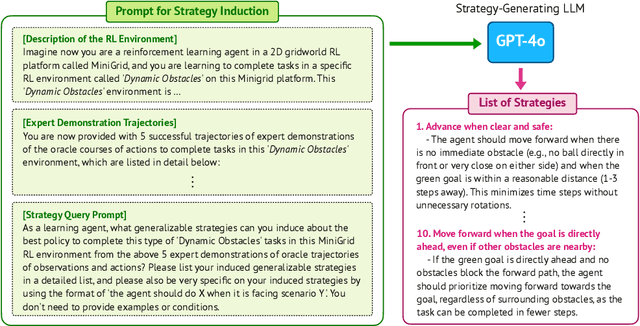

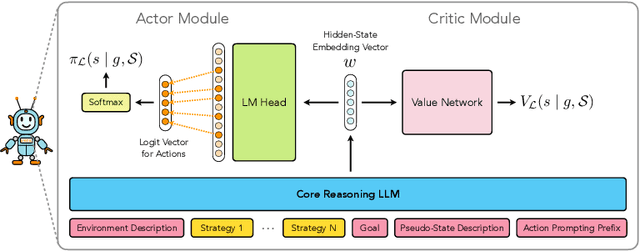
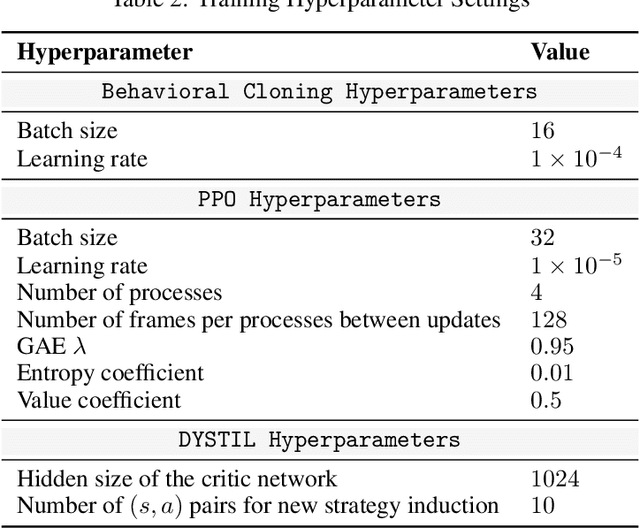
Abstract:Reinforcement learning from expert demonstrations has long remained a challenging research problem, and existing state-of-the-art methods using behavioral cloning plus further RL training often suffer from poor generalization, low sample efficiency, and poor model interpretability. Inspired by the strong reasoning abilities of large language models (LLMs), we propose a novel strategy-based reinforcement learning framework integrated with LLMs called DYnamic STrategy Induction with Llms for reinforcement learning (DYSTIL) to overcome these limitations. DYSTIL dynamically queries a strategy-generating LLM to induce textual strategies based on advantage estimations and expert demonstrations, and gradually internalizes induced strategies into the RL agent through policy optimization to improve its performance through boosting policy generalization and enhancing sample efficiency. It also provides a direct textual channel to observe and interpret the evolution of the policy's underlying strategies during training. We test DYSTIL over challenging RL environments from Minigrid and BabyAI, and empirically demonstrate that DYSTIL significantly outperforms state-of-the-art baseline methods by 17.75% in average success rate while also enjoying higher sample efficiency during the learning process.
Towards A Universal Graph Structural Encoder
Apr 15, 2025Abstract:Recent advancements in large-scale pre-training have shown the potential to learn generalizable representations for downstream tasks. In the graph domain, however, capturing and transferring structural information across different graph domains remains challenging, primarily due to the inherent differences in topological patterns across various contexts. Additionally, most existing models struggle to capture the complexity of rich graph structures, leading to inadequate exploration of the embedding space. To address these challenges, we propose GFSE, a universal graph structural encoder designed to capture transferable structural patterns across diverse domains such as molecular graphs, social networks, and citation networks. GFSE is the first cross-domain graph structural encoder pre-trained with multiple self-supervised learning objectives. Built on a Graph Transformer, GFSE incorporates attention mechanisms informed by graph inductive bias, enabling it to encode intricate multi-level and fine-grained topological features. The pre-trained GFSE produces generic and theoretically expressive positional and structural encoding for graphs, which can be seamlessly integrated with various downstream graph feature encoders, including graph neural networks for vectorized features and Large Language Models for text-attributed graphs. Comprehensive experiments on synthetic and real-world datasets demonstrate GFSE's capability to significantly enhance the model's performance while requiring substantially less task-specific fine-tuning. Notably, GFSE achieves state-of-the-art performance in 81.6% evaluated cases, spanning diverse graph models and datasets, highlighting its potential as a powerful and versatile encoder for graph-structured data.
HyperCore: The Core Framework for Building Hyperbolic Foundation Models with Comprehensive Modules
Apr 11, 2025



Abstract:Hyperbolic neural networks have emerged as a powerful tool for modeling hierarchical data across diverse modalities. Recent studies show that token distributions in foundation models exhibit scale-free properties, suggesting that hyperbolic space is a more suitable ambient space than Euclidean space for many pre-training and downstream tasks. However, existing tools lack essential components for building hyperbolic foundation models, making it difficult to leverage recent advancements. We introduce HyperCore, a comprehensive open-source framework that provides core modules for constructing hyperbolic foundation models across multiple modalities. HyperCore's modules can be effortlessly combined to develop novel hyperbolic foundation models, eliminating the need to extensively modify Euclidean modules from scratch and possible redundant research efforts. To demonstrate its versatility, we build and test the first fully hyperbolic vision transformers (LViT) with a fine-tuning pipeline, the first fully hyperbolic multimodal CLIP model (L-CLIP), and a hybrid Graph RAG with a hyperbolic graph encoder. Our experiments demonstrate that LViT outperforms its Euclidean counterpart. Additionally, we benchmark and reproduce experiments across hyperbolic GNNs, CNNs, Transformers, and vision Transformers to highlight HyperCore's advantages.
Position: Beyond Euclidean -- Foundation Models Should Embrace Non-Euclidean Geometries
Apr 11, 2025Abstract:In the era of foundation models and Large Language Models (LLMs), Euclidean space has been the de facto geometric setting for machine learning architectures. However, recent literature has demonstrated that this choice comes with fundamental limitations. At a large scale, real-world data often exhibit inherently non-Euclidean structures, such as multi-way relationships, hierarchies, symmetries, and non-isotropic scaling, in a variety of domains, such as languages, vision, and the natural sciences. It is challenging to effectively capture these structures within the constraints of Euclidean spaces. This position paper argues that moving beyond Euclidean geometry is not merely an optional enhancement but a necessity to maintain the scaling law for the next-generation of foundation models. By adopting these geometries, foundation models could more efficiently leverage the aforementioned structures. Task-aware adaptability that dynamically reconfigures embeddings to match the geometry of downstream applications could further enhance efficiency and expressivity. Our position is supported by a series of theoretical and empirical investigations of prevalent foundation models.Finally, we outline a roadmap for integrating non-Euclidean geometries into foundation models, including strategies for building geometric foundation models via fine-tuning, training from scratch, and hybrid approaches.
 Add to Chrome
Add to Chrome Add to Firefox
Add to Firefox Add to Edge
Add to Edge